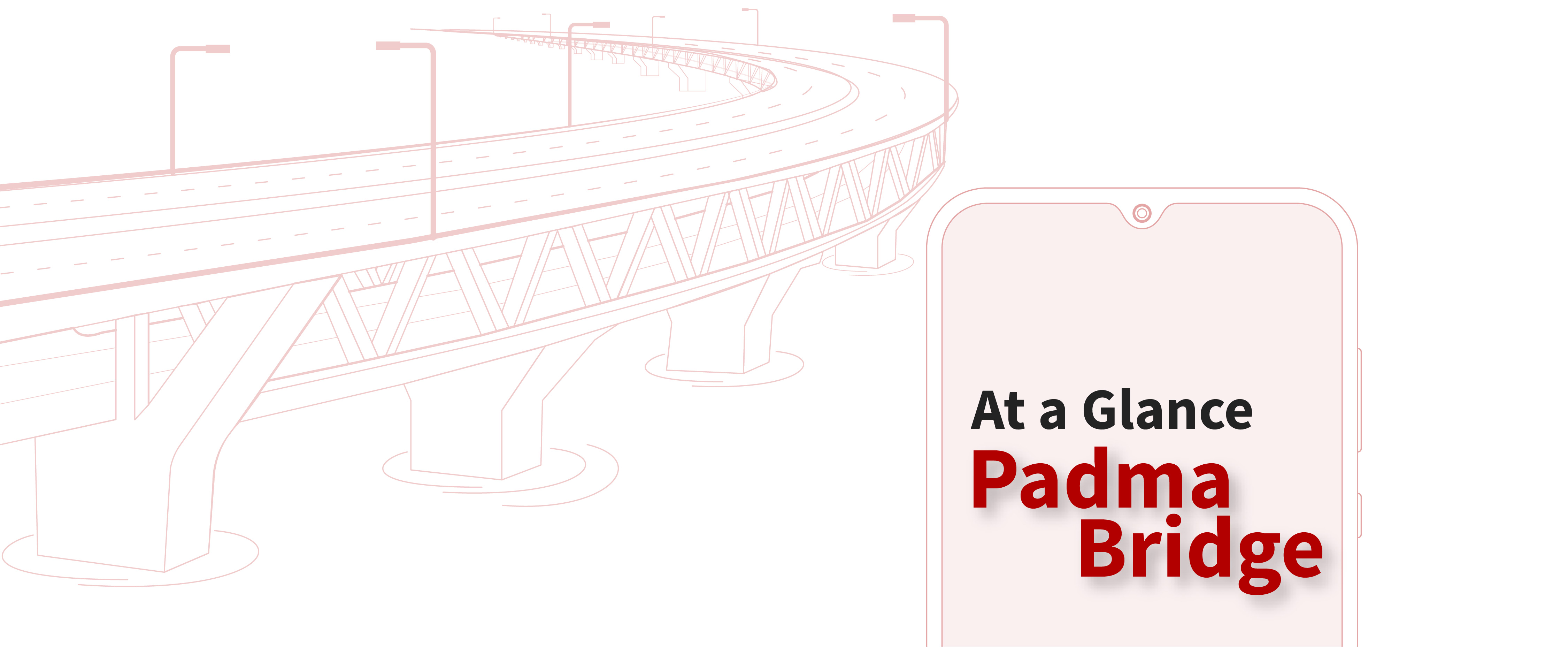
Padma Bridge at a Glance
- On July 31, 2022
The Padma Bridge is a multipurpose road-rail bridge across the Padma river. It is the largest bridge in Bangladesh. That connects Mawa, Louhajong, and Munshiganj to Janjira, and Shariatpur, linking the southwest of the country to the northern and eastern regions.
The hurdles between the two regions have existed for a long time. The Padma bridge's construction will be a boon for both regions. The Padma Bridge is more than just a construction or commercial endeavor. It connects families, cultures, and other things from two parts of the country. In addition, the Padma Bridge will revolutionize Bangladesh's economy. The social and economic changes will be significant. The following is a brief overview of the Padma Bridge:
1. Padma Bridge Length:
Padma Bridge has a length of 6.150 km and a width of 18.18 m. Total spans are 41 and each span is 150 meters long. The total piles of the bridge are 286 out of which 262 piles are made of steel and 24 piles are made of concrete. Padma Bridge is the longest in the country as the total length of the bridge is 6.15 km.
2. Districts That Padma Bridge Connects:
The bridge simply links the southwest of the country to the northern and eastern regions. It connects Munshiganj District, sitting on the southern outskirts of Capital city Dhaka, to Shariatpur & Madaripur districts, two southern regions located just on the banks of Padma River. The bridge is paving the way for the economic development of both the regions along with the nation as a whole.
3. Economic Impact of the Bridge:
The Padma Bridge will have a multiplier effect on economic activity across the nation. It is estimated that there will be 1.7% of growth in national GDP in the southwest region and 0.56% countrywide. Padma bridge has 29% growth in the construction sector, 9.5% in agriculture, and 8% in manufacturing and transportation. Then poverty will drop by 1% in the region, and 0.8% nationally. This bridge is also expected to generate employment for 1.2% of the total labor force. Tourism will get a boost as the travel time between the capital and the southeast region will be reduced by one-fourth.
4. Padma Bridge’s Impact on the Transportation Industry:
Padma bridge connects the two regions of the country. More transit users indicate that the transportation system will be faster. Due to the increased number of vehicles using the bridge, goods can be transferred more easily from one location to another. People will have more access to daily necessities since vehicles like trucks, covered vans, and cargo vans can transport many goods. As the country's southwestern regions become more integrated, everyone will have improved access to services including education, healthcare, and other necessities. The Padma Bridge will benefit the transportation industry, which will significantly improve the lives of thousands of people.
5. Padma Bridge Tolls:
You have to pay a certain amount of money to use the Padma Bridge. Padma Bridge toll list is given below:
| Motorcycle | Tk 100 |
| Car/Jeep | Tk 750 |
| Pickup | Tk 1,200 |
| Microbus | Tk 1,300 |
| Minibus | Tk 1,400 |
| Medium bus | Tk 2,000 |
| Big bus | Tk 2,400 |
| Truck (up to 5 tonnes) | Tk 1,600 |
| Truck (5-8 tonnes) | Tk 2,100 |
| Truck (3 axles) | Tk 5,500 |
| Trailer (4 axles) | Tk 6,000 |
| Trailer (above 4 axles) | Tk 6,000+ |
6. Utility Services through the Bridge:
The Government will provide various utility services through the bridge. The southern region of the country will get important facilities while traveling through the bridge. The list of the utilities is given below:
- 760 mm gas transmission line through Padma bridge
- Fiber optic and Telephone duc which is 150 mm.
- High voltage electric line will help both regions of the country.
7. Vehicles to Cross Everyday:
By 2022, 24,000 vehicles are expected to cross the Padma Bridge every day, and by 2050, it is anticipated that over 67,000 vehicles will have done so, according to research by the Japan International Cooperation Agency (JICA). According to the report, the bridge will save about 6,81,600 liters of fuel every day.
Categories
Recent Posts
- ENJOY UP TO TK1,250 DISCOUNT (4%) BY USING PROMO CODE: CARRY25
- ENJOY UP TO TK 1,500 DISCOUNT (4%) BY USING PROMO CODE: BIGMOVE25
- How Mr. Afzal Unlocked Great Profit With Truck Lagbe’s 18 Feet Truck Feature!
- How to Book a Shifting Service Using the Truck Lagbe App
- ENJOY 5% DISCOUNT (UP TO ৳500) BY USING PROMO CODE: DARUN25
Things to consider before buying a fridge

What features can you get from TL Tracker to ensure your truck's safety?

